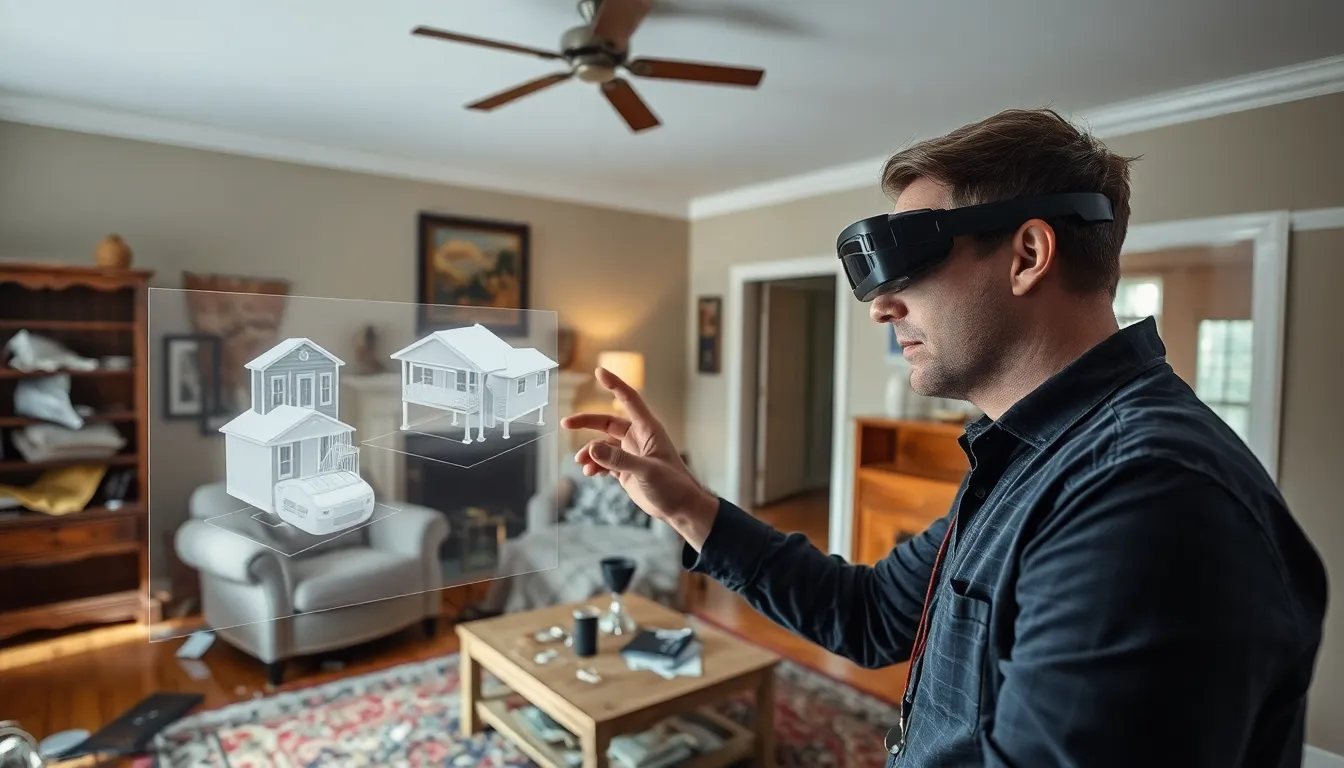Table of Contents
ToggleImagine a world where filing an insurance claim feels less like a trip to the dentist and more like a stroll through a virtual wonderland. Augmented reality (AR) is stepping in to transform the often tedious process into something engaging and efficient. By merging the real world with digital enhancements, AR is revolutionizing how claims are assessed, making it easier for both insurers and policyholders to navigate the complexities of the claims process.
With AR, adjusters can visualize damage in real-time, pinpointing issues faster than you can say “where’s my check?” This innovative technology not only speeds up the claims process but also boosts accuracy, ensuring that everyone walks away happy—or at least less grumpy. So, buckle up as we explore the advantages of augmented reality in insurance claims, and discover how this tech is turning the claims experience from a headache into a high-five.
Overview of Augmented Reality in Insurance Claims
Augmented reality (AR) significantly changes how insurance claims are processed. This technology enhances the adjuster’s ability to assess damage accurately and efficiently. Through AR, adjusters can overlay digital information onto a physical environment, providing a clearer understanding of the claim situation.
Using AR, adjusters visualize damage in real-time. For example, they can see structural issues on a property while assessing damages from a covered incident. This technology not only speeds up the assessment process but also reduces the likelihood of human error.
Training and onboarding new claims personnel become more effective with AR. Interactive visualizations help them grasp complex scenarios quickly. New team members can experience simulated claims adjustments, ensuring they gain hands-on experience without the risk of miscommunication.
Claims processing timelines tighten due to AR’s capabilities. Adjusters can document findings in real-time, streamlining paperwork and leading to faster claim resolutions. Furthermore, communication with policyholders improves through enhanced visual explanations and demonstrations.
AR enables insurance companies to maintain a competitive edge in the market. Firms that adopt this technology not only engage customers more effectively but also bolster customer satisfaction. By integrating AR into the claims process, insurance companies pave the way for an innovative approach to traditional practices.
Enhanced Accuracy in Damage Assessment

Augmented reality greatly enhances damage assessment accuracy in insurance claims. This technology seamlessly integrates the physical and digital realms, allowing for precise evaluations.
Real-Time Data Capture
Real-time data capture enables adjusters to document damage as it occurs. Utilizing AR, they overlay digital models on actual damaged objects, ensuring clarity in the assessment process. This capability minimizes discrepancies often seen in traditional assessment methods. They access data from various sources instantly, thus reducing the time taken to validate claims. In addition, the ability to collect and analyze data in real-time facilitates immediate reports for stakeholders, enhancing overall transparency.
Improved Visualization Techniques
Improved visualization techniques transform how adjusters perceive damage. Overlaying 3D images of damage onto a physical environment provides a comprehensive view of the situation. These visual aids not only clarify the extent of damage but also help in identifying the specific areas requiring attention. Adjusters showcase findings with augmented reality presentations, making communication with policyholders more effective. The use of AR simplifies complex information, turning it into easily digestible visuals that convey essential details efficiently.
Streamlined Claim Processing
Augmented reality transforms the claims process into a swift and efficient system. This technology facilitates smoother interactions between adjusters and policyholders while improving turnaround times.
Reduced Processing Time
AR technology significantly decreases the time required to process claims. Adjusters gather data in real-time, allowing for quicker damage assessments. Immediate access to visual overlays leads to faster decisions. By eliminating delays typical in traditional claims processes, AR enhances overall satisfaction for both adjusters and clients.
Increased Efficiency through Automation
Automation tools integrated with AR streamline data entry and reporting tasks. Adjusters can rely on AR applications to capture and organize information effectively. This efficiency reduces human error and speeds up the validation of claims. Increased accuracy in documentation fosters trust between insurance companies and their clients. Additionally, with automated workflows in place, personnel can focus on more complex claim issues, ultimately leading to a better claims experience.
Better Customer Experience
Augmented reality transforms the customer experience in insurance claims, making it more interactive and satisfying. Through immersive technology, policyholders engage more actively throughout the claims process.
Engaging Client Interactions
AR allows clients to visualize claims in real-time, fostering a collaborative environment. Interactive 3D models of damages provide clarity, enabling policyholders to understand each aspect better. Clients appreciate being part of the assessment process when adjusters use AR tools. This involvement builds trust and strengthens relationships. Engaging visuals captivate attention, turning mundane discussions into meaningful conversations about claims.
Improved Communication
Communication between adjusters and policyholders becomes clearer with augmented reality. By overlaying digital information onto physical damage, adjusters articulate findings more effectively. Visual aids clarify complex topics, reducing misunderstandings. Enhanced transparency in assessments encourages open dialogues about claims. Immediate access to visual data enables adjusters to address concerns quickly, ensuring clients feel heard. This streamlined communication reinforces confidence in the claims process, promoting higher satisfaction rates among policyholders.
Cost-Effectiveness for Insurance Companies
Cost-effectiveness stands as a key advantage of augmented reality in the insurance claims process. AR technology can significantly reduce operational costs for insurance companies by streamlining assessments. Adjusters leverage real-time data capture, ensuring accurate documentation with fewer manpower hours required.
Training expenses drop substantially due to enhanced onboarding processes utilizing AR simulations. New adjusters can immerse themselves in realistic scenarios, expediting their learning curve without the need for extensive training sessions.
AR also minimizes field visit requirements, reducing travel costs and time for adjusters. By enabling virtual assessments, companies decrease the frequency of physical inspections while still ensuring thorough evaluations.
Faster claim processing times lead to cost savings, allowing companies to handle more claims simultaneously. The reduction of human errors fosters financial efficiency, as fewer incorrect payments occur when using AR for visual assessment.
Enhanced accuracy in damage assessments directly correlates with improved cost management. Adjusters can understand claim situations better with digital overlays, leading to fewer disputes and less expenditure on re-evaluations.
Streamlined communication with policyholders decreases the potential for misunderstandings, preventing costly repercussions. Clear and concise information transfer results in quicker decisions, ultimately driving down administrative costs.
Through these various avenues, AR technology not only optimizes the claims process but also ensures that insurance companies remain competitive. Implementing augmented reality effectively translates into a more profitable framework for claims handling.
Augmented reality is reshaping the insurance claims landscape by enhancing efficiency and accuracy. Its ability to provide real-time visualizations transforms how adjusters assess damage and interact with policyholders. This technology not only reduces processing times but also fosters a collaborative environment that builds trust between clients and insurers.
As AR continues to evolve, its cost-effectiveness and improved training methods will further solidify its role in the industry. Insurance companies that embrace this innovative approach are likely to see increased customer satisfaction and a competitive advantage in the market. With augmented reality leading the way, the future of insurance claims looks promising and more user-friendly.







